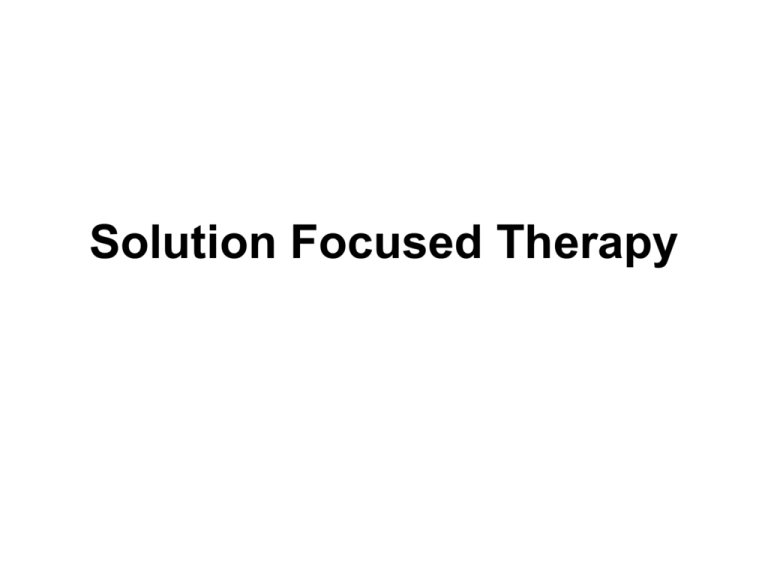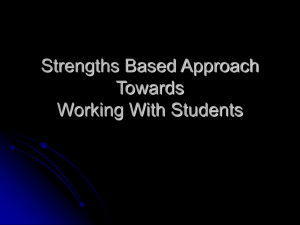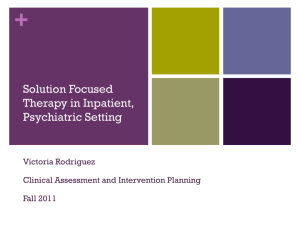Solution Focused Therapy
advertisement

Solution Focused Therapy SOLUTION-FOCUSED THERAPY A short-term approach to intervention in which the social worker and client attend to solutions or exceptions to problems more so than to problems themselves. It helps clients identify and amplify their strengths and resources toward the goal of finding solutions to presenting problems. Principles If it ain’t broke, don’t fix it If it works, keep doing it If it’s not working, stop Small change leads to larger change Keep intervention as simple (concrete) as possible UNIQUE ASSUMPTIONS OF SOLUTION FOCUSED THERPY There is no necessary connection between problems and solutions Events in a person’s past and present are not necessarily causally connected One need not understand a problem in order to resolve it Depth is not synonymous with truth BASIC APPROACH OF SOLUTION-FOCUSED THERAPY Two Primary Activities Development of well-formed goals within the client’s frame of reference Development of solutions based on exceptions The Process Describe the problem Develop goals Explore for exceptions End of session feedback Evaluate client progress (each session) SOLUTION-FOCUSED INTERVENTION THROUGH THE HELPING PROCESS The Social Worker’s General Approach Give Compliments (Direct and indirect) Ask Future- Oriented Open-Ended Questions The worker’s language should always imply the likelihood of change Emphasis is on the future when the problem no longer exists “What will you be doing when _____ “ The Pessimistic Stance (gets clients to argue for their own change) “It sounds like the problem is serious. How come things are not worse?” “What are you (or your family) doing to keep things from getting worse? “How has that been helpful? Would _____ agree?” The Social Worker’s General Approach (Cont.) Reframe Introduce clients to new ways of looking at themselves or the problem issue Externalize Discuss the problem as something apart from the client, rather than something that is central to the client’s nature “You struggle with substance abuse” vs. “You are a substance abuser” THE SOCIAL WORKER’S ACTIVITIES Facilitate: Change talk (seeking differences) Solution talk (constructing preferred futures) Strategy talk (for managing the problem) via: Coping questions Present multiple options Scaling (levels of confidence, motivation, and progress) If the client is comfortable, he or she will disclose all of what is important GOALS OF THE FIRST SESSION Build positive feelings and a sense of hope: “Tell me what will be different for you when our time here has been successful.” Assessment Topics Client’s perceptions of the problem Client’s beliefs about the sources of the problem How the problem affects the client How the client has coped with the problem thus far What the client has tried already What the client’s experiences have been with other helpers CREATE A CLIMATE FOR CHANGE Inquire about Pre-Session Change “Has anything changed relative to the presenting problem since you set up this appointment?” “Are these the kinds of changes you would like to continue see happen?” Do not minimize the significance of any efforts the client has made, or any changes that may have occurred prior to the first meeting CLARIFY THE CLIENT’S GOALS FOR INTERVENTION Encourage clear problem definition Prioritize (work on only one problem at a time) The Miracle Question - “Imagine when you go to sleep one night a miracle happens……. but you don’t know it…… what would be the first signs for you that ……” Perspective of the client Perspective of a significant other Partialize problems into discreet, measurable units Scaling questions (for goal setting and assessing motivation) CHARACTERISTICS OF WELL-FORMULATED GOALS Realistic Challenging Include the possibility of interpersonal interaction Situational (vs. broad) focus Concrete, measurable Focus on the presence of desirable behavior rather than the absence of a behavior Enable a focus on “steps” rather than a final result Client recognizes a role for him or herself EXPLORING FOR EXCEPTIONS Exceptions - past experiences in a client’s life when the problem might reasonably have been expected to occur, but somehow did not Recent exceptions are more useful to intervention Random versus deliberate exceptions Also ….. Identify the client’s areas of competence, strengths Identify protective factors that can be mobilized EXAMPLES OF EXCEPTIONS QUESTIONS “What was going on in the past when the problem wasn’t a problem?” “Tell me about a time recently when the problem did not exist (or was less troublesome)“ “How did you make that (the exception) happen?” “What were you thinking?” “Who was there?” “How did they have a part in creating the exception?” “When did it happen?” “Where did it happen?” “What did you think and feel as a result of doing that?” EXPLORE TASK IDEAS The End-of-Session “Message” Compliments Summary statement of positive strategies Tasks Personal functioning Interactions with others Interactions with resource systems The Formula First Session Task “Between now and the next time we talk, notice the things in your life that you would like to continue” SUBSEQUENT SESSIONS Ask: “What’s better?” Client should be encouraged to report positive and negative developments Clients may be ambivalent about “positive” changes that involve loss Ask questions about: Maintenance strategies “What needs to happen for these changes to keep happening? What obstacles may get in your way, and how might you overcome those?” Learning strategies “What have you learned so far from what you’ve been doing? What have you learned not to do?” REVIEW TASK PERFORMANCE All session-to-session tasks should be jointly designed by the social worker and client; the client should take the lead in devising them Practitioners vary in the importance they place on the specificity of tasks, their accomplishment, and “reporting in” The client’s lack of or inability to follow through with a task signals the need to renegotiate tasks or goals or to review motivation Scaling questions regarding progress and confidence. Use of a 0 - 10 scale promotes specificity of focus and concrete indicators of movement DEVELOP OR REINFORCE NEW STRATEGIES FOR CHANGE Build on what the client is already doing Don’t focus too much on setbacks, but ask: Should you be doing something different? Are your goals realistic? Your timetable? What did you do to stop it from getting worse? How did you cope with the problem not improving? Possibly revisit the miracle question (clients may change their answers) The Surprise Task - “Between now and the next time we meet, do something that will pleasantly surprise _____ (a significant other person)” EVALUATE EACH SESSION Evaluation Questions “Is our work together helpful to you? Are the changes along the lines that you hoped? Have your goals changed? What should we be doing differently?” During each session ask the client (on a 0 to 10 scale) what number will signify good-enough problem resolution After a goal is achieved, set additional goals or end the intervention Remind the client at the end of each session how progress toward goal achievement is being demonstrated SOLUTION-FOCUSED INTERVENTION WITH “VISITORS” Maintain the position of “not knowing” Agree with the client’s perceptions of the presenting situation Assume that there are good reasons for the client’s negativity Ask the client to elaborate on feelings of anger and negativity Turn client complaints into beginning goals for the intervention Listen for other people who are important to the client Ask what previous professional helpers” (if any) could have done differently to be more helpful Ask for the client’s perceptions of “best interest” and what he or she wants Make sure non-negotiable requirements are clear Give the client as much control of the intervention process as possible INTERVENTION WITH CLIENTS IN CRISIS “How can I help?” “What have you tried already?” “What do you want to be different?” Ask Coping Questions “How do you get out of bed in the morning?” “How did you survive long enough to get here today?” “How have you managed to cope this far?” “How come things are not worse?” QUESTIONS TO ASK WHEN ENDING INTERVENTION “What do you need to remember if things get difficult for you again?” “What will be the benefits for you that will make the effort worth it?” “Who is going to be able to help you? “Who do you think will be more a part of the problem?” “How long do you think it will take before this is not a big problem anymore?” “How will you remind yourself about the things you know are helpful?” “What do you expect the hardest challenge will be?” “What do you think the possible obstacles might be, and how will you overcome them?” SFT IDEAS THAT ARE “TRANSFERABLE” TO OTHER APPROACHES Considering the balance of time spent discussing the client’s past, present, and future Scaling and the miracle-question can be useful when the social worker feels “stuck” with a client Attention to the client’s coping strategies can correct against a deficits bias It is not always necessary to look for detailed explanations of client problems The danger of fostering client dependency on formal intervention CRITICISMS OF SOLUTION-FOCUSED INTERVENTION The practice denies clients the opportunity to explore presenting problems in greater depth Its encouragement of clients to "think positively" may induce denial or minimization of problems Clients may feel discouraged from sharing important details or negative feelings about the presenting issue SFT may create a false impression on young practitioners that intervention is relatively “easy” or straightforward








